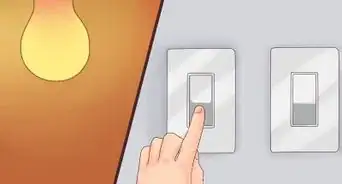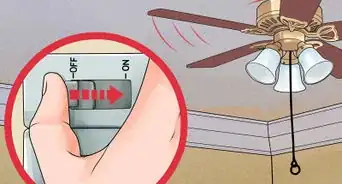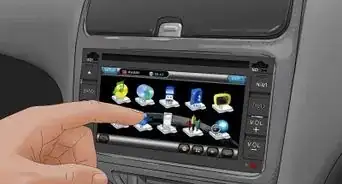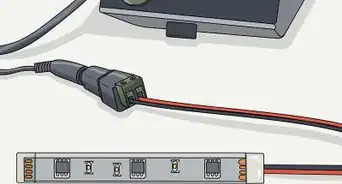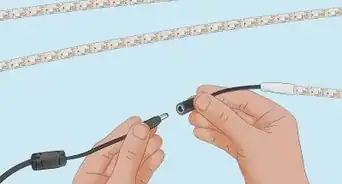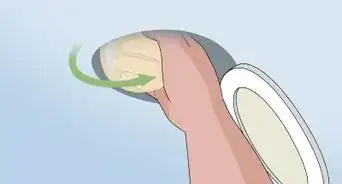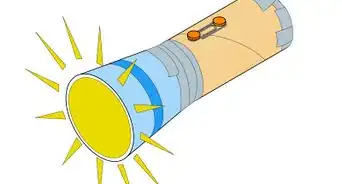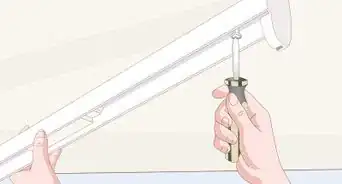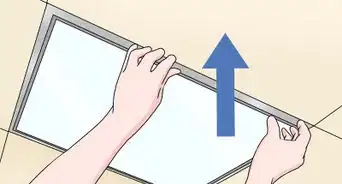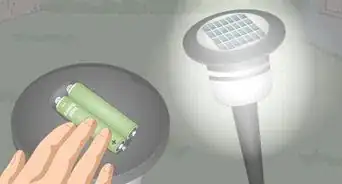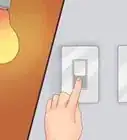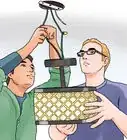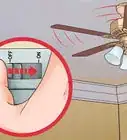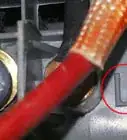This article was co-authored by James Hornof. James Hornof is a Master Electrician and the Owner and President of B & W Electric based in Denver, Colorado. With over two decades of experience in the electrical construction industry, James specializes in field installation, management, estimating, and design. He graduated top of his class in electrical trade school and studied Business Management at The Community College of Denver. James holds a Master Electrician license in Colorado, Wyoming, and Texas.
This article has been viewed 1,548,343 times.
A 3-way light switch allows you to control a light source from two separate points.[1] Although a 3 way is one of the hardest electrical circuits to figure out, it's also one of the most useful.
Note: there are several ways to install a 3 Way Light Switch. The methods shown here are some of the safest and most versatile, though not the only options.
Steps
Wiring the Switches
-
1Flip off power in the room you're working.[2] Head to your fuse box and make sure there is no power coming to the room you're currently working in. Use a voltage detector to ensure that you're not going to shock yourself once you start working.
-
2Screw your two boxes and light fixture into place, then gather your supplies. Before you even start wiring, you want to get the fixtures securely in place so that you can effectively wire everything together. You will need:
- Two 3-Way Switches
- Two 2-wire non-metallic (NM) cable
- One 3-wire NM cables
- 2 6" pieces of grounding wire
Advertisement -
3Slide the 2-wire NM power cable into the first switch box. Take your power wire, coming from the house, and slide it into the first switch box. Choose a direction that will make it easy for you to then thread the wire towards your second switch box.
-
4Remove about 9 inches of sheathing from the wire. Strip off enough of the rubber coating around your NM wire to expose the wires underneath. Some people prefer to do this before feeding into the switch box, but it doesn't matter.
- You want roughly 3" of wire in the box, and 6" outside the box.
-
5Run a 3-wire NM cable between the first and second boxes. Strip 6-9" on one end to expose the three separate wires, then run the first half into your first switch box. Repeat on the other end and run it into your second switch box. Cut the cable to length if there is extra once you pull through the second box.
- This third wire allows power to run to your second switch even if the first one is off.
-
6Use a cable staple to secure the wires to the wall or stud within 8" of the box. Cables must be secured so that, if there is tugging or pulling further down the line, the live wires don't rip out of the box and cause issues. Some boxes have clamps to hold onto the wires. Current electrical codes require any switch box without built-in clamps to have the wires secured within eight inches of the box.
- Secure to the center of the stud, in the wall, so that it will not be hit by drywall studs later on if you were to hang anything near the light.
-
7Pull another 2-wire NM cable through the second switch box, just like you did in the very beginning with the first box. The only difference is that this 2-wire cable is not a power cable from the wall -- it is a free-hanging cable that you will use to attach the light. Be sure to strip 9" and pull the wires through into the second switch box.
- Be sure to secure all wires within 8" of the box.
-
8Pull the 2-wire cable from the second box up and into the light fixture. Strip away 6-9" of the sheathing and pull your wires in so that they can attach to the light. Again, be sure to use a cable staple to support the wire within 8" of the box.
-
9Strip 1" off of the individual ends of all the smaller wires. A 2-wire NM cable is actually made up of smaller wires, run together for convenience. You exposed those wires already, but now you need to strip the rubber sheath off of the very end of each of these little wires.
-
10Curve the ends of every black and red cable into small hooks. This will make them easier to attach to the actual switches. You'll hook this around a screw, which you then tighten to clamp down the wire to the light switch.
- The should look like little canes.
- This is often easiest with needle-nose pliers.
-
11Use wire nuts to attach the each set of two white wires together. Twist the two white, neutral wires together in each box and twist on a wire nut. Keep twisting until the wires are secured and the nut stays in place when let go. There are two sets to attach--
- The pair in the first switch box
- The pair in the second switch box
-
12Use wire nuts to attach the two pairs of green/orange grounding wires together, adding a 6" piece of copper grounding wire to each pair as well. Take all three ends and hold them together, then twist on the wire nut so they are all securely fastened together. You should have two wires tracing back through your NM cables, and one hanging ground wire on each set.
- This extra grounding wire will be attached to the light switches. It is called a "pigtail" in electrical parlance.
-
13After making all your connections, fold the wires neatly into the box. You want to zig-zag them, so they come about a bit like an accordion. You can tuck the wires in the light switch back too -- though they didn't get any work done. Your two switch boxes should each be wired identically, like so:
- Two white, neutral wires tied off by a wire nut.
- Two grounding wires, plus one pigtail, tied off by a wire nut.
- A red wire, with the end stripped and curled.
- A black wire, with the end stripped and curled.
-
14Replace the drywall, coverings, etc. before moving on. By now, the wiring part is actually done. You'll just need to attach the cables appropriately to the switches and light now -- but the fixtures will be uncovered by your wall anyway. Everything "behind the scenes" is mostly done.
Installing the Switches and Light
-
1Attach the black power cable (from the wall) to the general screw (black) in the three-way light switch. Hook the curled end of the wire under the screw, then tighten down the screw to hold the wire firmly in place. This screw is usually in the upper left side of the switch and is painted black, but check the guide that comes with your switch if you're unsure.
- Not all switches are made for three-way wiring. Make sure you purchase accordingly.
- There should be two black wires in your box -- one from the power source, one leading to the other box. Make sure you use the power wire.
-
2Attach the remaining black and red cables (from 3-wire NM) to the traveler screws on the switch. These screws, often gold, will be on opposite sides of the switch. Hook the red one up to the side with you black power wire, and the black on the identical screw on the other side of the switch.
-
3Attach the hanging ground wire (the pigtail) to the green grounding screw. There should only be one screw left, and it is for that small, 6" free cable attached to the grounding wires. Loop it around the screw and fasten it down like any other cable.
-
4Attach the black wire leading to the light to your general screw (black). The wiring on the second switch is nearly identical to the first, except for this key difference: the black wire goes to the light, not to the power source." Once you have this wire screwed down, the rest are identical:
- Attach the grouped red and black cables (from 3-wire NM) to the traveler screws
- Attach the pigtail wire to the grounding screw.
-
5Attach the appropriate wires to your light fixture. You should have a space for a neutral wire (white), a grounding wire, (orange or green) and a power wire (black). They will screw on easily, and your light is set. Replace the covers for the switches, screw them into place, and turn the power back on to be in business.
Alternative Wirings
-
1Select the proper wire size. If originating from an electric panel or fuse box, #12 copper is the minimum size when connecting to a 20 amp circuit breaker or fuse; #14 copper is the minimum size when connecting to a 15 amp circuit breaker or fuse (aluminum wire on circuits of these capacities has been prohibited for many years).
- The size of all the wires in any circuit must be the same size. When obtaining power from a nearby electrical outlet or another circuit device, the new wiring must be the same size as those that supply the outlet.
-
2Select the proper cable type. The power supply or feed cable should be "2 wire" (or conductor) cable plus a ground wire. See below for descriptions and uses of common cable types.
-
3Shut power off. This is a very important step. Please do not skip it.
-
4Install a 2 wire cable between the power source (outlet box, electric panel, etc) and the first switch box. Leave 8–10 inches (20.3–25.4 cm) of wire inside both boxes (source and first switch) before cutting the cable to facilitate easy connection to the switch and power source. Connect the ground wire to the circuit ground wire(s) with a wire nut or other approved connection (see How to Connect Electrical Wire). The ground wire should be connected to the neutral terminal bar. Finally, connect the black wire to the hot supply or the circuit breaker / fuse and the white to the neutral supply or neutral terminal bar in the electrical panel.
- If equipped with a separate ground bar, rather than connecting to the neutral terminal bar, the ground wire can connect to the ground terminal bar. However, if all the existing ground wires connect to one bar and all the existing white wires connect to a different bar, maintaining separate ground and neutral connections is required.
- Never introduce ground wire(s) to a terminal bar with only white or gray insulated wires connected or vice versa.
- If the power source is an electrical panel or fuse box, the cable should be cut at least long enough to reach the furthest termination point (breaker or fuse, ground and neutral bar) without the need of splicing.
-
5Install a 3 wire cable from the first switch box to the light fixture's box. Leave 8–10 inches (20.3–25.4 cm) of wire inside each of the boxes before cutting the cable to facilitate easy splicing and connection to the switch and fixture.
- A 3 wire cable has an "extra" wire when compared to 2 wire cables, and this wire is nearly always covered in red insulation. This third wire is necessary for 3-way switch installations.
-
6Install a 3 wire cable from the second switch box to the light fixture's box. Leave 8–10 inches (20.3–25.4 cm) of wire inside each box before cutting the cable to facilitate easy splicing and connection to the fixture.
-
7Connect ground wires, which is usually green.[3] Provide as shorter lengths (8 inches/20.5 cm) of bare or green insulated wire to this wire-nutted group to allow connection to green ground terminal screws on each device in the box (switches, outlets, fixtures, etc.) - one length of insulated wire per ground terminal screw. If the switch or junction box is metal, it too must be securely grounded with a green ground screw or approved grounding clip. This must be done at each and every box that a cable enters and at each device that provides a termination point for ground.
- It is highly recommended that you complete these ground connections first, and then gently fold them into the rear of the box - out of the way - leaving only the shorter ground leads out for easy connection to devices.
- No ground connection is made to plastic, fiber or another non-conductive box.
-
8Connect feed wires in the first switch box. First, connect all ground wires as previously described. The 2 wire cable feed from the power source enters the bottom of the switch box and the hot (black) wire connects to the common or shunt terminal on the 3-way switch. There is only one such terminal on a 3-way switch, and it is usually identified as the one having a different color terminal screw (often significantly darker) from the other two terminal screws (not counting the green ground screw).
- Connect the 3 wire cable's white insulated wire (neutral) directly to the 2 wire 'feed' white insulated (neutral) wire with wire nuts (there is no connection of any white wires to this switch).
-
9Connect 3 wire cable in the first switch box. The 3 wire cable enters through the top of the first switch box. The red insulated wire connects to either one of the 2 unused terminal screws (shown in the image above to be on the top left and right sides of both 3-way switches). It does not matter to which terminal screw this wire is connected.
- Connect the black insulated wire to the remaining unused terminal screw on the switch.
-
10Connect wires in the light fixture's box. Again, connect all ground wires as previously described, if not already completed. In the light fixture's box, there will be two 3 wire cables. One 3 wire cable originates at the first switch box and has its white insulated wire as a neutral. The other 3 wire cable originates at the second switch box and will become the "switch leg". Mark both ends of this wire by wrapping it with black electrical tape to alert others working on the circuit later that it is no longer neutral. This is a newer electrical code requirement, but has been a common practice whenever a white or gray wire is / or can become hot.
- Connect the two red insulated wires together with a wire nut.
- Connect the black wire coming from the first 3-way switch and the white "switch leg" wire coming from the second 3-way switch (has black tape wrapped around it) together with a wire nut.
-
11Connect 3 wire cable in the second switch box to the switch. Connect all ground wires as previously described, if not already completed. Connect the black insulated wire to the shunt or common terminal screw of the switch (once again, the common screw terminal is the different colored screw from the rest of those on the switch).[4]
- Connect the red insulated wire to one of the two unused terminal screws (it does not matter which).
- Connect the "switch leg" (white wire with black tape) to the remaining unused terminal screw on the switch.
-
12Connect the fixture. The light fixture's box should have only a black wire, a white wire and a ground wire to supply power to the fixture.
-
13Finish up. Check all wire nuts for tightness and exposed neutral and hot conductor surfaces. Fold all wires carefully into the boxes and secure devices and fixture with screws. Install plates and covers. Restore power and test.
Understanding Common Cable Types
-
1Understand non-metallic cables. NM (also called "Romex®") and UF ("underground feeder") cables both have plastic jacket wrapped around 2 (or more) insulated wires - including one white and one black - and a single uninsulated wire.[5]
- NM is used indoors and UF is used outdoors, when subjected to sunlight, or when buried underground.
- NM cable is easier to work than other cable types, requires no special tools or preparation, and costs less. For these reasons, it is widely used. It is not, however, authorized for use in all installations, such as being embedded in concrete or where exposed to the risk of physical damage.
-
2Understand armored cable types, including BX, MC and AC. Armored cable types are very similar with only slight variations. They consist of a metal jacket formed by an interlocking, helically wound band of steel or aluminum around two (or more) insulated wires - including one white, one black, and often one green. Cables lacking a green insulated wire use the outer metal jacket as the ground conductor. Type AC is fabricated with a continuous internal bonding conductor in contact with the metal sheath.
- Of these armored cable types, only Type NM can be installed outside or for direct burial underground, and only if listed (tested) and labeled for that purpose.
-
3Know the restrictions of each cable type. There are unique precautions and instructions for each type and special connectors for armored cables. For example, do not use a Romex (Type NM) connector on an armored cable, even though many connectors appear similar.
-
4If the power source is from an armored cable that lacks a full size (#12 or #14) ground wire, use a metal box to extend the ground from the armored shell to the box and to the circuit's ground wire. Do this by threading a special green, hex-headed grounding machine screw into a pre-tapped hole in the metal box, or use a special green ground clip.
-
5Become familiar with cable naming conventions. All of these cables have "trade names" which are basically derived from the number of insulated non-ground conductors, construction type and manufacturers' names. For example, a "twelve-two (12/2) Romex®" cable has two #12 conductors, plus a full sized #12 ground. A "fourteen-three (14/3) BX" cable is a metal-armored cable with three #14 conductors, plus a full sized #14 ground. Some types of BX are also tested and approved for using the sheath as a grounding or bonding conductor.
Community Q&A
-
QuestionWhere can I find a good diagram for wiring a 2 way switch?
 Community AnswerA basic two-way switch is pretty straight forward. You'll only have three screws. The green is for the ground wire and the other two on either side are for the black (hot) wire. The white (neutral) wire is not connected to it (it is typically just wire-nutted in the box). The idea behind a switch is that it opens or closes the connection on the black wire when you flip it.
Community AnswerA basic two-way switch is pretty straight forward. You'll only have three screws. The green is for the ground wire and the other two on either side are for the black (hot) wire. The white (neutral) wire is not connected to it (it is typically just wire-nutted in the box). The idea behind a switch is that it opens or closes the connection on the black wire when you flip it. -
QuestionCan I wire a three-way switch as a two-way?
 Community AnswerYes, but it's probably better to replace it with a regular, single-pole switch. Then you'd connect the black power wire to one side of the switch and the black wire from the light to the other side of the switch and connect the white neutral wires together.
Community AnswerYes, but it's probably better to replace it with a regular, single-pole switch. Then you'd connect the black power wire to one side of the switch and the black wire from the light to the other side of the switch and connect the white neutral wires together.
Warnings
- Check you local wiring rules, as your local wiring system may use a different color combination.⧼thumbs_response⧽
- Never mix wire sizes or materials (copper and aluminum).⧼thumbs_response⧽
- Remember to turn off the power before you do any electrical work.⧼thumbs_response⧽
Things You'll Need
- Romex cable both 12.2 and 12.3 (for 20 amp circuits) OR 14.2 and 14.3 (for 15 amp circuits).
- Two 3-way light switches
- One light box
- Two switch boxes.
- Wire cutters
- Wire stripper or knife.
- Wire nuts
- Straight blade and Philips screwdriver.
References
- ↑ http://www.homeimprovementweb.com/information/how-to/three-way-switch.htm
- ↑ James Hornof. Master Electrician. Expert Interview. 7 September 2021.
- ↑ James Hornof. Master Electrician. Expert Interview. 7 September 2021.
- ↑ James Hornof. Master Electrician. Expert Interview. 7 September 2021.
- ↑ http://www.homedepot.com/c/factors_to_consider_when_wiring_your_home_HT_BG_EL
- Videos provided by iCreatables
About This Article
To wire a 3 way light switch, you'll need 2 3-way light switches, 2 2-wire non-metallic cables, 1 3-wire non-metallic cable, and 2 6-inch grounding wires. First, run a 2-wire cable from the wall power to the black screw on 1 of the switches. Then, connect the 2 switches by splitting the 3-wire cable apart and attaching each of the 3 wires to one of the other 3 screws on each switch. Finally, run the last 2-wire cable from the second switch's black screw to the light. To learn alternate wiring methods and how to ground the switches, read more!

